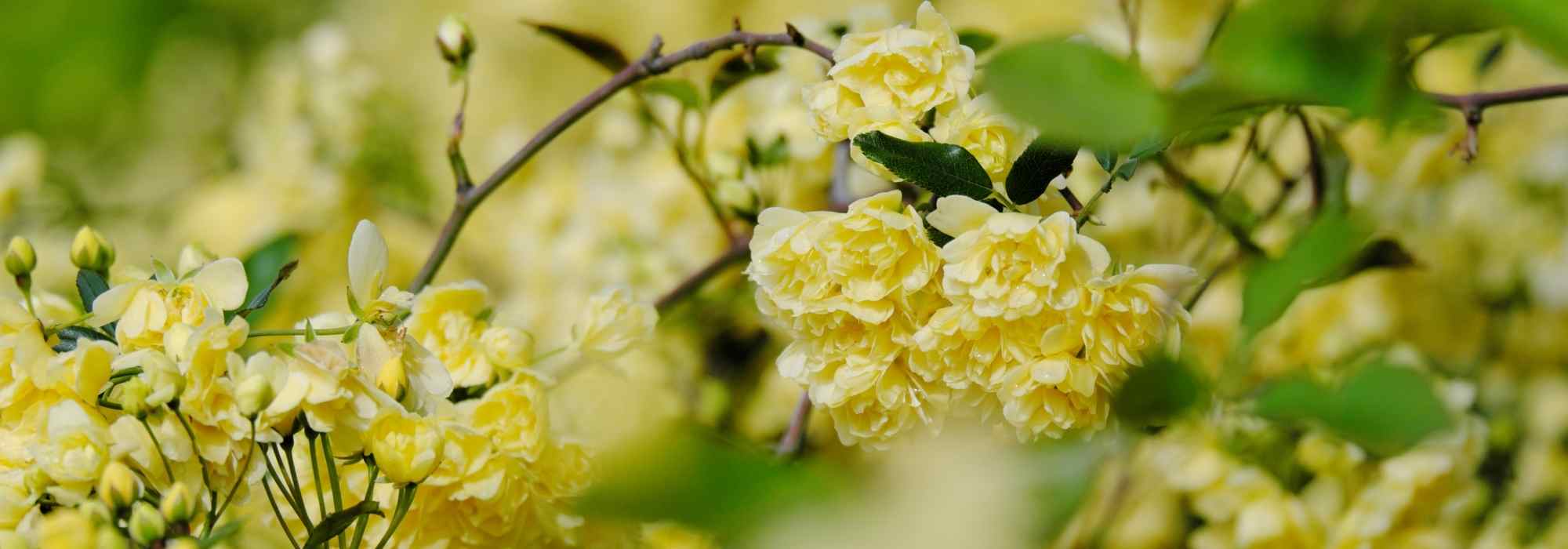
Banks' Rose: Succeeding in Its Cultivation
Our planting and care tips
Contents
The Banks’ Rose (Rosa banksiae) is a particularly vigorous rambling rose that is spectacular in mild climates. With a remarkably early non-repeat flowering, it blooms very early, sometimes as soon as March depending on the region, and in abundance, producing clusters of small yellow, white, or pink roses. Other qualities include being generally completely thornless, almost immune to diseases, and requiring very little maintenance. Pruned to conquer and quickly adorn large spaces in just 4 or 5 years, it can climb very high, reaching up to 15 metres in height and 6 metres in spread. It will take little time to cover a trellis, wall, large arbour, pergola, or any other imposing support, or even to race from trees to shrubs.
The Banks’ Rose would have only advantages if it weren’t a bit tender! Hardy down to -10/-12 °C in well-drained soil, it can still be adopted in many regions, in a sheltered position and in full sun.
Here are all our secrets for successfully growing the Banks’ Rose!
Choosing the right variety
According to the varieties, the flowers are single or double, yellow, white, or soft pink, and are generally well-scented. Quite resistant to hybridization, this type of rose only comes in a few remarkable varieties of non-repeat flowering roses! Very vigorous, they all grow quickly, are wonderfully floriferous, and often retain their lush foliage in winter.
- The Banks’ Rose ‘Alba’: this is the wild form of the species, displaying simple, white, fragrant roses throughout May (sometimes earlier). Rare in cultivation, it is however thornless, is not very susceptible to diseases, and can grow up to 10 m high.
- The Banks’ Rose ‘Alba Plena’: this very elegant and monumental variety, thornless, stands out for its small, well-double cream-white flowers with a delightful violet fragrance. It only flowers once, in May, but is incredibly floriferous.
- The Banks’ Rose ‘Lutea’: this is undoubtedly the most vigorous and widespread of the Banks roses. It produces clouds of small, very double moon-yellow roses very early in spring. It compensates for its non-fragrant flowering with exceptional floribundity.
- The Banks’ Rose ‘Rosea’: it bears small, double roses of a very bright pink for 3 to 5 weeks in April-May. They are slightly fragrant. This variety is more susceptible to rose diseases.
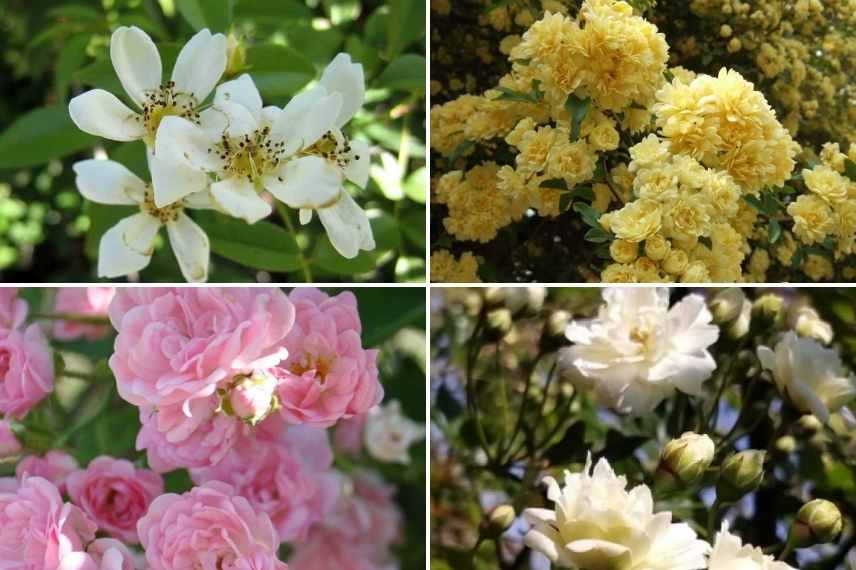
The different cultivars of Banks’ Rose; ‘Alba’, ‘Lutea’, ‘Rosea’, and ‘Alba Plena’
Read also
Pegging rosesExpose it to the sun.
Throughout the year, your Banks Rose requires plenty of sunshine and will need a very sunny location. A bit sensitive to cold, it is “THE” ideal rose for the Mediterranean climate, fearing neither the heat nor the dryness of its summers, once well established. It is particularly better suited than other roses to dry conditions. However, it can bloom outside the olive zone, provided it is given a very sunny exposure, sheltered from cold and violent winds, for example by placing it against a south-facing wall. North of the Loire, it will need protection from the harshness of winter and severe frosts to preserve its foliage and flowering. Once well rooted, it will be able to regrow from the stump even after severe frost.
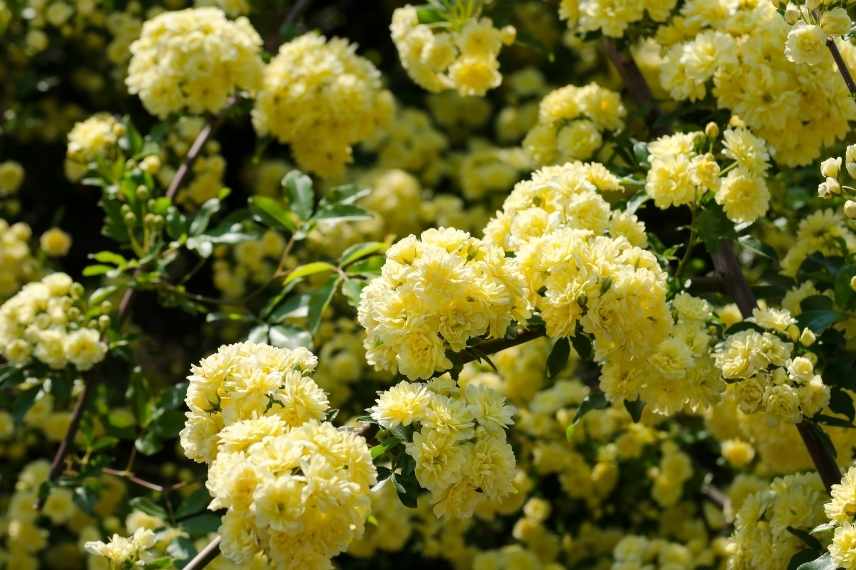
Rosa Banksiae ‘Lutea’
Discover other Rambling Roses
View all →Available in 0 sizes
Available in 1 sizes
Available in 2 sizes
Available in 3 sizes
Available in 2 sizes
Available in 2 sizes
Available in 2 sizes
Plant it in the right soil.
Not demanding regarding soil type, the Banks Rose has the ability to thrive in calcareous terrains. It can flourish in various types of soils as long as they are sufficiently deep. Indeed, this rose grows on its own roots and will seek moisture deep in the soil, even during very dry summers. Although it tolerates poor soils, we recommend planting it in very well-drained and ideally fertile soil.
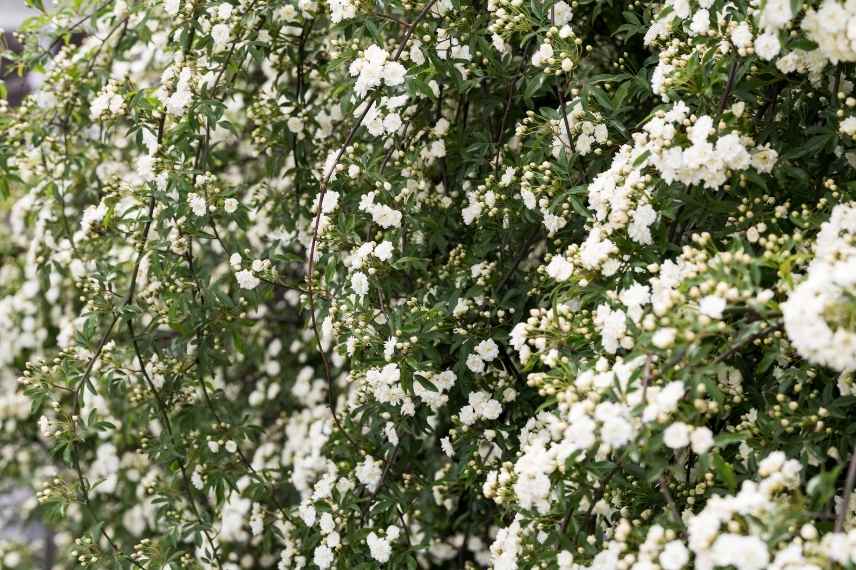
Banks Rose ‘Alba’
Read also
Diseases of rosesWell attach it
It is necessary to guide this rambling rose and harmoniously direct its stems from the moment of planting. The Banks Rose can be trained on various supports: south-facing wall, tree, pergola, arch, trellis… Training should be done progressively as it develops. Ensure a sufficiently sturdy support to bear the weight of this large rose.
- Direct the growth of the stems horizontally, which will encourage them to ramify.
- Select the 3 or 4 most beautiful stem shoots to train.

On a sturdy arch or along a façade, take care in training your Banks rose
Well bent!
To achieve a more abundant flowering of your Banks roses, you can practise pegging (also known as arching): a technique applied to roses that produce long, flexible shoots to increase the number of flowers. Those of Banks roses can grow 1 m in 8 days during summer. This involves bending and regularly tying the branches as horizontally as possible to their support to stimulate the production of floriferous shoots along the entire length of the shoot. Each bend encourages the growth of a lateral shoot that will, in turn, bear roses. Feel free to use this technique before the resumption of growth in spring.
→ More tips in our sheet on pegging roses
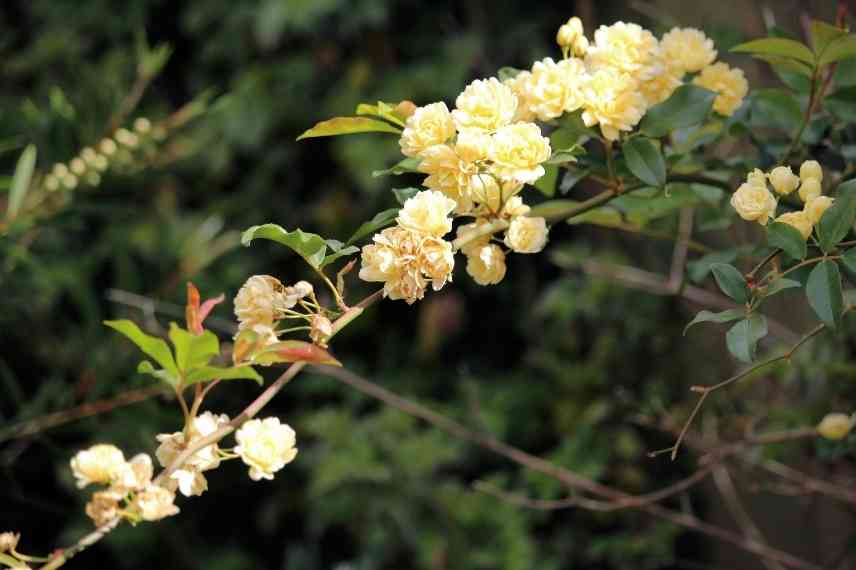
Bend the shoots as horizontally as possible
Pruning wisely
Pruning can be useful for densifying the habit, ramifying the base, and containing its vigour, at least during its early years. Like non-repeat flowering climbing roses, Banks roses bloom on one- or two-year-old stems. Therefore, if you prune them at the end of winter, you will miss out on the stems formed the previous year that are about to flower. Pruning should therefore be done just after flowering:
- Shorten the shoots by 30%
However, when your rose reaches over 2 metres, pruning will become unmanageable, if not impossible! Once mature, this type of rose with monumental growth is no longer pruned. You will simply rejuvenate it by removing dead or diseased wood at the end of winter.
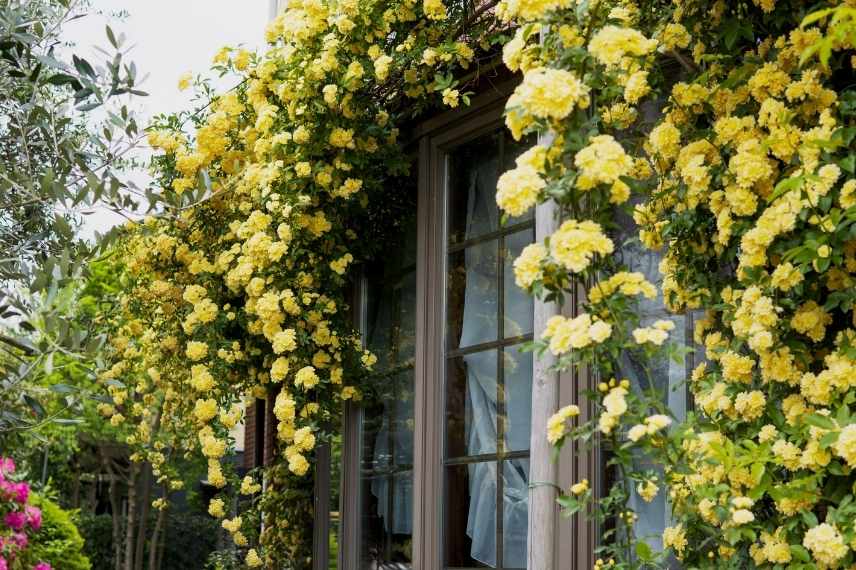
Prune your Banks rose in its early years
Maintain it well
Very vigorous, it requires almost no maintenance. Watering is only necessary during the first year after planting, to encourage better establishment. Once mature, except in cases of exceptional drought, rainwater will suffice.
Regularly remove faded flowers with clean pruning shears.
Protect it from diseases
The Banks rose is a robust plant with foliage that is not very susceptible to rose diseases. However, it may be necessary to protect it with a preventive treatment in spring and summer. When the climate is humid and warm, powdery mildew and downy mildew can settle on the leaves and flower buds. The former is visible as a white fluff covering them, while the latter appears as black spots. You can spray preventively in spring with a copper-based product such as Bordeaux mixture.
Protect it from the cold
Its hardiness is around -10 to -12 °C in well-drained soil. It can thrive as far as the Paris region, protected by a wall well-exposed to the south or sheltered from cold winds by a hedge. In cool climates, we recommend protecting its young stump during the first 2 or 3 years, with mulching and the aerial parts with a winter cover.
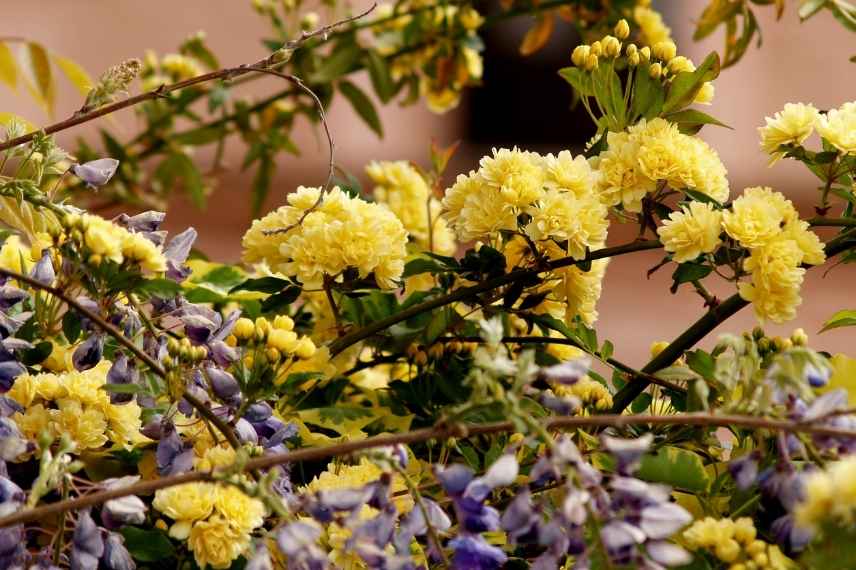
Well sheltered and installed along a protective wall and in the sun, the Banks rose can establish itself in many regions
- Subscribe!
- Contents
































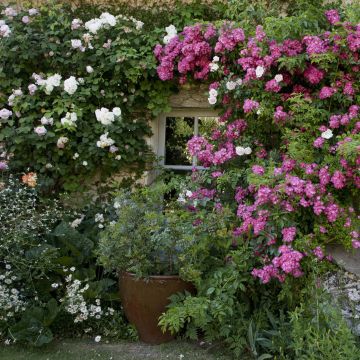


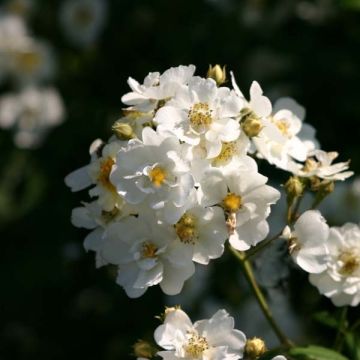
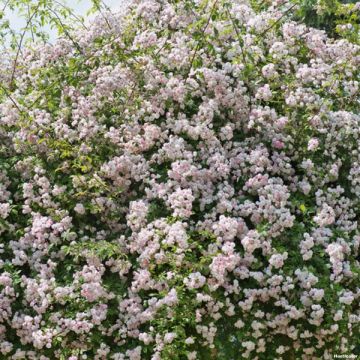
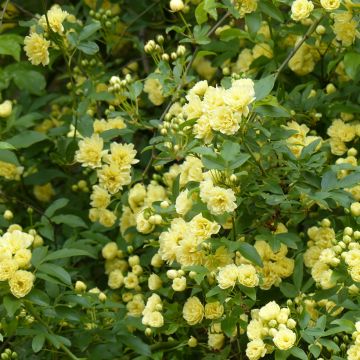
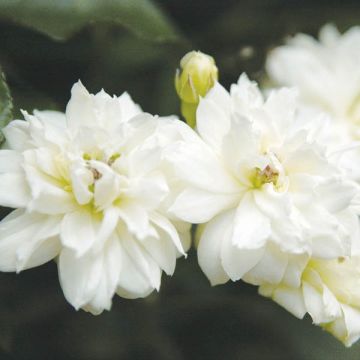



Comments